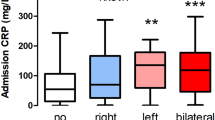Abstract
Purpose
Early recognition of neoplastic pericarditis (npe) is crucial for the planning of subsequent therapy. The aim of the present study was to construct the scoring system assessing the probability of npe, in the patients requiring pericardial fluid (pf) drainage due to large pericardial effusion.
Methods
One hundred forty-six patients, 74 males and 72 females, entered the study. Npe based on positive pf cytology and/or pericardial biopsy specimen was recognised in 66 patients, non-npe in 80. Original scoring system was constructed based on parameters with the highest diagnostic value: mediastinal lymphadenopathy on chest CT scan, increased concentration of tumour markers (cytokeratin 19 fragments—Cyfra 21-1 and carcinoembryonic antigen—CEA) in pf, bloody character of pf, signs of imminent cardiac tamponade on echocardiography and tachycardia exceeding 90 beats/min on ECG. Each parameter was scored with positive or negative points depending on the positive and negative predictive values (PPV, NPV).
Results
The area under curve (AUC) for the scoring system was 0.926 (95%CI 0.852–0.963) and it was higher than AUC for Cyfra 21-1 0.789 (95%CI 0.684–0.893) or CEA 0.758 (95%CI 0.652–0.864). The score optimally discriminating between npe and non-npe was 0 points (sensitivity 0.84, specificity 0.91, PPV 0.9, NPV 0.85).
Conclusion
Despite chest CT and tumour marker evaluation in pericardial fluid were good discriminators between npe and non-npe, the applied scoring system further improved the predicting of neoplastic disease in the studied population.


Similar content being viewed by others
References
Adler Y, Charron P, Imazio M et al (2015) 2015 ESC guidelines for the diagnosis and management of pericardial diseases. Eur Heart J 36:2921–2964
Maisch B, Ristic A, Pankuweit S (2010) Evaluation and management of pericardial effusion in patients with neoplastic disease. Prog Cardiovasc Dis 53:157–163
Orbach A, Schliamser JE, Flugelman MY, Zafrir B (2016) Contemporary evaluation of the causes of cardiac tamponade: acute and long-term outcomes. Cardiol J 23:57–63
Sanchez-Enrique C, Nunez-Gil IJ, Viana-Tejedor A et al (2016) Cause and long-term outcome of cardiac tamponade. Am J Cardiol 117:664–669
Kim SH, Kwak MH, Park S et al (2010) Clinical characteristics of malignant pericardial effusion associated with recurrence and survival. Cancer Res Treat 42:210–216
Rafique AM, Patel N, Biner S et al (2011) Frequency of recurrence of pericardial tamponade in patients with extended versus non-extended pericardial catheter drainage. Am J Cardiol 108:1820–1825
Numico G, Cristofano A, Occelli M et al (2016) Prolonged drainage and intrapericardial bleomycin administration for cardiac tamponade secondary to cancer-related pericardial effusion. Medicine(Baltimore) 95:e3273
Lestuzzi C, Bearz A, Lafaras C et al (2011) Neoplastic pericardial disease in lung cancer: impact on outcomes of different treatment strategies. A multicenter study. Lung Cancer 72:340–347
Tomkowski W, Wiśniewska J, Szturmowicz M et al (2004) Evaluation of intrapericardial cisplatin administration in cases with recurrent malignant pericardial effusion and cardiac tamponade. Supp Care Cancer 12:53–57
Maisch B, Ristic AD, Pankuweit S et al (2002) Neoplastic pericardial effusion: efficacy and safety of intrapericardial treatment with cisplatin. Eur Heart J 23:1625–1631
Burazor I, Imazio M, Markel G, Adler Y (2013) Malignant pericardial effusion. Cardiology 124:224–232
Li BT, Pearson A, Pavlakis N et al (2014) Malignant cardiac tamponade from non-small cell lung cancer: case series from the era of molecular targeted therapy. J Clin Med 4:75–84
Pawlak-Cieślik A, Szturmowicz M, Fijałkowska A et al (2012) Diagnosis of malignant pericarditis: a single centre experience. Kardiol Pol 70:1147–1153
El Haddad D, Iliescu C, Yusuf SW et al (2015) Outcomes of cancer patients undergoing percutaneous pericardiocentesis for pericardial effusion. JACC 66:1119–1128
Ristic AD, Imazio M, Adler Y et al (2014) Triage strategy for urgent management of cardiac tamponade: a position statement of the European Society of Cardiology Working Group on Myocardial and Pericardial Diseases. Eur Heart J 35:2279–2284
Sun JS, Park KL, Kang DK (2010) CT findings in patients with pericardial effusion: differentiation of malignant and benign disease. AJR 194:489–494
Maggiolini S, De Carlini CC, Ferri LA et al (2016) The role of early contrast-enhanced chest computed tomography in the aetiological diagnosis of patients presenting with cardiac tamponade or large pericardial effusion. Eur Heart J Cardiovasc Imaging 17:421–428
Paganuzzi M, Onetto M, Marroni P et al (2001) Diagnostic value of Cyfra 21-1 tumour marker and CEA in pleural effusion due to mesothelioma. Chest 119:1138–1142
Szturmowicz M, Tomkowski W, Fijałkowska A et al (2005) Diagnostic utility of Cyfra 21-1 and CEA assays in pericardial fluid for the recognition of neoplastic pericarditis. Int J Biol Markers 20:43–49
Koh KK, Kim EJ, Cho CH et al (1994) Adenosine deaminase and carcinoembryonic antigen in pericardial effusion diagnosis, especially in suspected tuberculous pericarditis. Circulation 89:2728–2735
Karatolios K, Pankuweit S, Maish B (2013) Diagnostic value of biochemical markers in malignant and non-malignant pericardial effusion. Heart Fail Rev 18:337–344
Antonangelo L, Sales RK, Cora AP et al (2015) Pleural fluid tumour markers in malignant pleural effusion with inconclusive cytologic results. Current Oncol 22:e336
Hsieh TC, Huang WW, Lai CL et al (2013) Diagnostic value of tumor markers in lung adenocarcinoma-associated cytologically negative pleural effusions. Cancer Cytopathol 121:483–488
Author information
Authors and Affiliations
Corresponding author
Ethics declarations
Ethical approval
All procedures performed in the study were in accordance with the ethical standards of the institutional research committee and with the 1964 Helsinki declaration and its later amendments. The written consent of agreement for all diagnostic procedures was obtained from every patient.
Source of funding
This study was supported by the National Tuberculosis and Lung Diseases Research Institute, project no 3.10.
Conflict of interest
The authors declare that they have no conflict of interest.
Electronic supplementary material
ESM 1
(DOCX 13 kb)
Rights and permissions
About this article
Cite this article
Szturmowicz, M., Pawlak-Cieślik, A., Fijałkowska, A. et al. The value of the new scoring system for predicting neoplastic pericarditis in the patients with large pericardial effusion. Support Care Cancer 25, 2399–2403 (2017). https://doi.org/10.1007/s00520-017-3645-4
Received:
Accepted:
Published:
Issue Date:
DOI: https://doi.org/10.1007/s00520-017-3645-4




